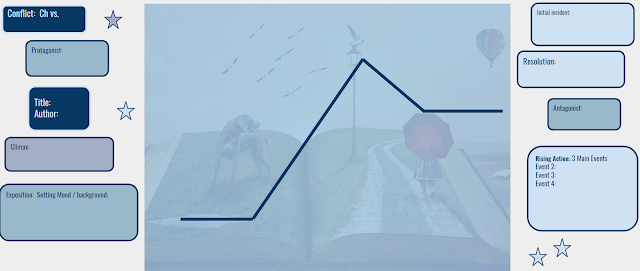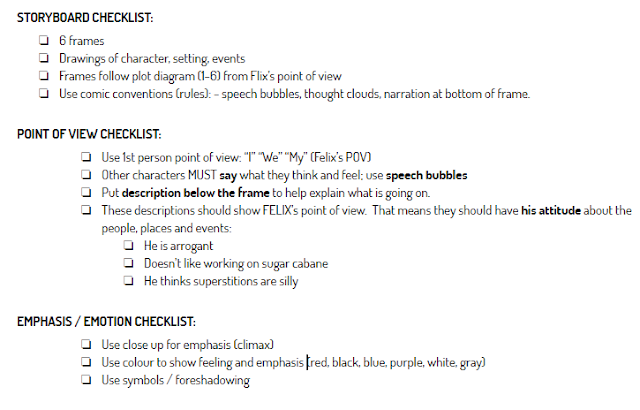Fantastic Fiction

What are the elements of fiction?
How do I identify conflict and explain how it is developed and resolved?
How are characters developed? How can I make sound predictions in a story?
What literary elements improve readers experiences? How?
How represent understanding of narratives? What forms might these interpretations take?
- I predict and discuss the consequences of events or characters’ actions, based on information in stories, poems and videos 2.2.5
- I identify and explain conflict, and discuss how it develops and may be resolved 2.2.8
- I identify the narrator’s perspective, and explain how it affects the overall meaning of a text 2.3.4
- I identify and explain how narrative hooks, foreshadowing, flashback, suspense and surprise endings contribute to the effectiveness of plot development 2.3.5
- I express interpretations of oral, print and other media texts in another form or genre 2.2.4
- I create a variety of oral, print and other media texts to explore ideas related to particular topics or themes 2.4.4
INTRODUCING PLOT
First students took notes on plot diagram and conflict. See the image below:
Then we watch "Boundin'" and analyzed the plot. See analysis below:
Students signed up to analyze other short films:
Mrs. Anderson's YouTube Link: 7 Plot Intro
We shared our findings and presented in small groups.
Next we created flash cards to help us memorize plot diagram. AND we completed a Google Drawing: Plot Sort it Out!
READY to READ!!
"The White Owl," by Hazel Bozwell
We activated background knowledge by discussing symbols and superstitions. See student handout below.
We created definitions using the following slide show and partners, of course.
We read the story stopping to carify french vocabulary and do some thinking as a group. We broke the story into 3 chunks.
- Exposition - found foreshadowing and made predictions.
- Rising Action - discussing events and vocabulary with images to understand Quebec Culture and time period
- Resolution - to see the result of our predictions
Students completed digital plot diagram for this story.
We discussed and agreed with a peer on information from the story and the amount of detail needed for each box.
After the story students identified the point of view the story was told from and practiced identifying narrative point of view with a worksheet and taking Point of View Notes.
Students then examined comics as a story board by looking at a Calvin and Hobbes comic and adding Calvin's thoughts and opinions to this comic:
After the story students identified the point of view the story was told from and practiced identifying narrative point of view with a worksheet and taking Point of View Notes.
Students then examined comics as a story board by looking at a Calvin and Hobbes comic and adding Calvin's thoughts and opinions to this comic:
First as a whole class, students identified the main character and his point of view. Then, they decided how many frames to include and which conventions to use: speech bubbles, thought clouds and narration.
Then they practiced again, on their own.
We discussed feeling and emphasis and how to use closeup and colour to create both.
Students used storyboards to retell "The White Owl" from Felix's point of view. See Mrs. A's example:
Using a checklist we made improvements:
Then they practiced again, on their own.
We discussed feeling and emphasis and how to use closeup and colour to create both.
Students used storyboards to retell "The White Owl" from Felix's point of view. See Mrs. A's example:
Using a checklist we made improvements:
STORYBOARD RUBRIC Name: Class:
Criteria\Level
|
Excellent
|
Proficient
|
Satisfactory
|
Limited
|
I create a storyboard to explore a scene in “The White Owl” and show Felix’s point of view. 2.4.4, 2.3.1
Storyboard components:
|
Storyboard is comprehensive.
The components of the storyboard are very effective and used to provide a vivid picture of Felix’s experience.
|
Storyboard is substantial.
The components of the storyboard are effectively used to provide a complete picture of Felix’s experience.
|
Storyboard is partial.
The components of the storyboard are sometimes effective and used to provide a partial picture of Felix’s experience.
|
Storyboard is underdeveloped.
Few components of the storyboard are effective and used to provide an unclear picture of Felix’s experience.
|
How well do I use a storyboard to represent Felix’s experiences? Are all my frames complete? Do they include all components of a storyboard?
| ||||
I identify the narrator’s perspective and explain how it affects the overall meaning of a text.
2.3.4
Narrator’s perspective:
|
Felix’s point of view is vividly expressed by:
|
Felix’s point of view is clearly expressed by:
|
Felix’s point of view is sometimes expressed by:
|
Felix’s point of view is unclear and ineffectively expressed by:
|
Which frame best shows Felix’s attitude toward people or ideas? Explain what his attitude is and how it was created.
How is your story different now that Felix is telling it? What is clearer? What has been added?
| ||||
I experiment with illustrations to create emphasis or express emotion.
4.1.10
The overall emotion of the scene is…
Emphasis created by:
|
Illustrations are compelling; each frame looks different to emphasize something important or create emotion.
I consistently and effectively create emphasis and emotion with: close up and colour, foreshadowing or symbols.
|
Illustrations are effective and give clear emphasis and emotions in some frames.
I create emphasis effectively with: close up and colour, foreshadowing or symbols.
|
Illustrations are predictable and give a partial emotions in some frames.
I create emphasis somewhat effectively with: close up, colour, foreshadowing or symbols.
|
Illustrations lack appeal and give an unclear emotions in frames.
I do little to create emphasis with: close up, colour, foreshadowing or symbols.
|
Which frame gives a strong emotion? How does the image emphasise the feeling?
Which frame has strong emotion? What colours give this feeling?
| ||||

















No comments:
Post a Comment